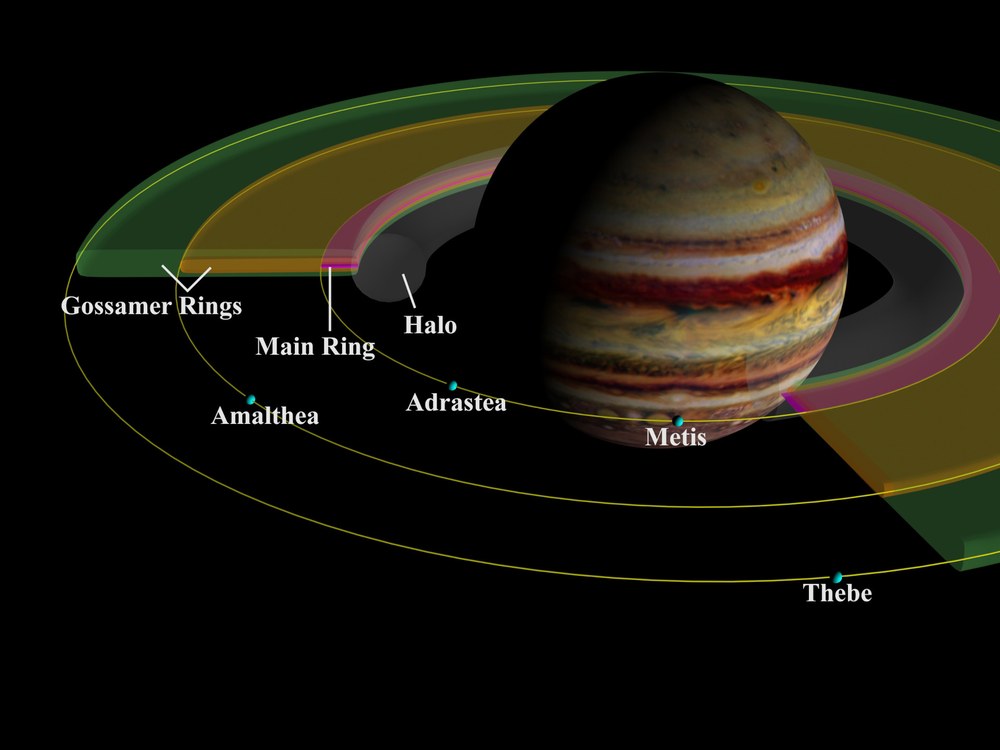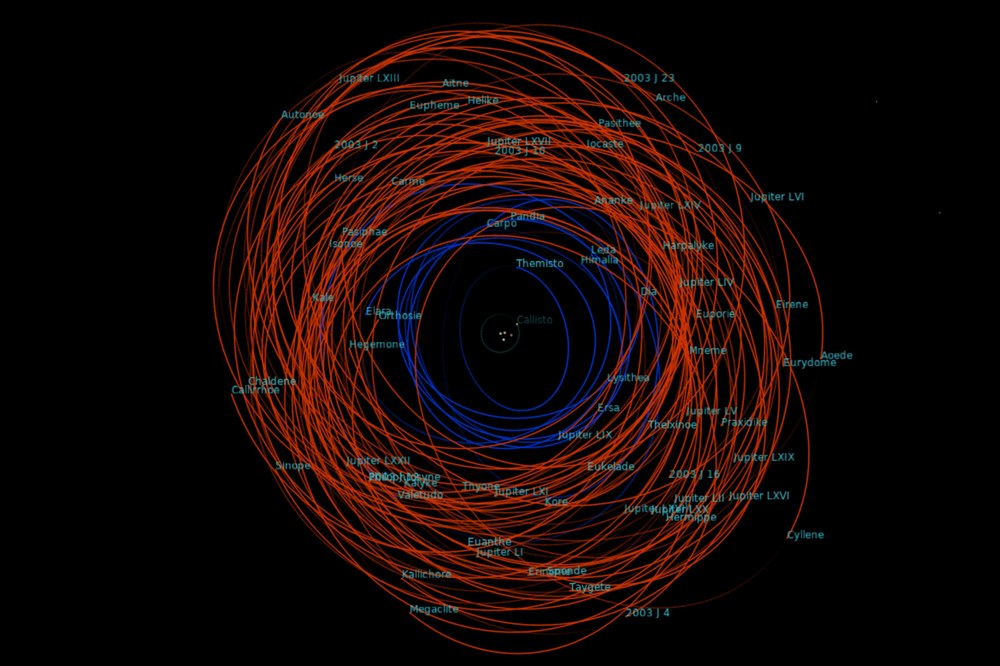The small moons of Jupiter



Jupiter has four large moons – Io, Europa, Ganymede and Callisto – with diameters of more than 3000 kilometres. However, as of April 2023, we know it is also home to 91 additional small satellites. Most of these moons are only a few kilometres across, and all of them are irregularly shaped. With a total of 95 moons, Jupiter has once again surpassed Saturn as the planet in our Solar System with the most moons. Saturn, Jupiter’s outer neighbour, currently has 83 known satellites.
The four larger moons mentioned above, also known as the 'Galilean moons', account for 99.997 percent of the total mass of Jupiter's moons. The other 91 moons account for only 0.003 percent. In contrast to the three moons of the inner Solar System – Earth's moon and the martian moons Phobos and Deimos – almost all satellites of the planets in the outer Solar System are home to one or more type of frozen volatile substance. This includes (primarily) water, as well as ammonia, nitrogen, sulphur dioxide and carbon monoxide or dioxide – some with extremely low freezing points.
It is likely that the four large moons were formed at the same time as Jupiter and in its immediate vicinity. For the small moons, it is assumed that they are more likely to be asteroids captured by gravity, or celestial bodies that 'got stuck' in orbit around Jupiter on their way to the inner Solar System from more distant regions such as the Kuiper belt beyond Neptune. Similar to the ‘Trojan’ asteroids that orbit the Sun 60 angular degrees ahead and behind Jupiter in its orbit, these very dark bodies are believed to be rich in carbon and could contain more complex organic molecules and numerous frozen volatile compounds. They are the target of NASA's Lucy mission, which launched in 2021 and in which the DLR Institute of Planetary Research is also involved.
Following the discovery of the Galilean moons in January 1610 by means of a thin telescope with a focal length of 133 centimetres and a magnification of 20, many great astronomers tried to find additional moons around Jupiter using increasingly powerful telescopes at observatories in Europe and the USA. However, it took more than 270 years before Edward Emerson Barnard (1857-1923), a self-taught astronomer and pioneer of astrophotography, discovered another satellite in 1892 using the 38-inch telescope of the Lick Observatory in California – the largest telescope in the world at the time.
Jupiter's four innermost moons
The moon, discovered by Barnard, orbits Jupiter within the orbit of Io and was named Amalthea after the nymph who, according to Greek mythology, fed Zeus with goat's milk in his childhood. Images acquired during the Galileo mission revealed that the moon is very irregularly shaped and has 'x-y-z axis lengths' of 131 by 73 by 67 kilometres. It always points its long axis at Jupiter and orbits the planet within 12 hours and at an altitude of 110,000 kilometres above the clouds. If Amalthea moved at a slower pace, it would plummet towards Jupiter and be ground to dust by its gravitational force. Amalthea was the fifth and last moon of Jupiter to be discovered through a telescope using sight alone. Subsequent discoveries were made by combining telescopes with analogue imaging – chemically coated photographic glass plates – and eventually with digital image sensors in the focal plane of terrestrial telescopes or in cameras on board spacecraft.
Three other satellites have been discovered within Io's orbit. Two of these are Metis (40 kilometres in diameter) and Adrastea (20 kilometres in diameter). They almost 'share' an orbit at an altitude of just under 130,000 kilometres above Jupiter's atmosphere. Within Jupiter's rings, they orbit the planet a few thousand kilometres apart, presumably delivering dust to the rings. Metis and Adrastea are the only two moons that orbit Jupiter faster than it rotates around its own axis. The moons are likely to break apart in astronomically 'short' periods of time: Jupiter's tidal forces put the bodies under great tension while also pulling their orbit inwards. Both bodies are already within the 'Roche limit', below which the tidal forces are greater than a satellite’s internal cohesion.
Thebe is the fourth small moon located within Io's orbit. It has a diameter of 100 kilometres and, like Metis and Adrastea, was discovered during the flybys of the two Voyager spacecraft in 1979 on images acquired by both onboard camera systems. An overview of the moons in the Jupiter system can be found on NASA's 'Solar System Exploration' pages. Detailed insights into (almost) all known moons of Jupiter can be found by following the 'In Depth' link.
Jupiter's four inner moons
Moon | Orbital Radius | Orbital Period | Diameter | Discovered by |
|---|---|---|---|---|
Metis | 128,000 kilometres | 0.3 days | 40 kilometres | Voyager |
Adrastea | 129,000 kilometres | 0.3 days | 20 kilometres | Voyager |
Amalthea | 181,000 kilometres | 0,5 days | 131 kilometres by 73 kilometres by 67 kilometres | Edward Barnard (1892) |
Thebe | 222,000 kilometres | 0,67 days | 100 kilometres | Voyager |
Comparison: The four Galilean moons
Moon | Orbital Radius | Orbital Period | Diameter | Discovered by |
|---|---|---|---|---|
Io | 422,000 kilometres | 1.77 days | 3636 kilometres | Galileo Galilei (1610) |
Europa | 671,000 kilometres | 3.55 days | 3120 kilometres | Galileo Galilei (1610) |
Ganymed | 1,070,000 kilometres | 7.15 days | 5268 kilometres | Galileo Galilei (1610) |
Callisto | 1,883,000 kilometres | 16.69 days | 4821 kilometres | Galileo Galilei (1610) |
The outer moons
In addition to the Galilean moons and the four inner moons, Jupiter is home to a further 87 satellites – although the orbits of these bodies are even less circular than those of the Galilean and inner moons.
The orbit of a moon around a planet – the 'primary body' – is described using three parameters:
- Does the satellite orbit the primary body in the same direction as it rotates around its own axis (prograde) – or in the opposite direction (retrograde)?
- How much is its orbit stretched into an ellipse (i.e. what is its eccentricity)?
- How much is its orbit inclined with respect to the planet's equatorial plane (i.e. what is its inclination)?
If the moon orbits the planet in the same direction as it rotates (prograde) and the eccentricity and inclination are less than five percent and five degrees respectively, it is referred to as a 'regular' natural satellite; if the moon orbits the planet retrograde, or if the eccentricity is more than five percent or the inclination is more than five degrees, it is an 'irregular' satellite.
Jupiter's outer moons are all irregular: some of their orbits have steep inclinations with respect to Jupiter's equator and are very much stretched into ellipses. Some of them reach as far from Jupiter (their ‘apojove’) as more than 20 million kilometres. For this reason, almost none of these bodies will be observable by the JUICE mission while it is orbiting Jupiter. There will, however, be three opportunities to observe them as JUICE first arrives in the Jovian system.
The vast majority of these moons orbit Jupiter retrograde, which, according to model calculations, leads to greater orbital stability. This implies that Jupiter probably had many more satellites in this dynamic moon population orbiting prograde. However, due to their lower orbital stability, these moons would have been 'kicked out' of their original Jupiter orbit by the giant planet's gravity or ground to dust. All 95 of Jupiter’s moons are tidally locked: their rotation period is identical to the orbital period around Jupiter. Thus, like Earth's moon, the same hemisphere is always facing the planet.
Names inspired by Greek mythology
Unlike the three inner moons discovered by the Voyager spacecraft, all of these outer moons were discovered using telescopes on Earth. Previous missions have been unable to discover any further moons using their instruments. However, during its flyby in December 2000, the Cassini spacecraft succeeded in acquiring images of the largest of these outer moons, Himalia (diameter 170 kilometres), from a distance of 4.4 million kilometres.
The large number of satellites beyond the Galilean moons is divided into groups or 'families' based on orbital properties. The largest body in each group is given a name, for example Themisto, Himalia, Ananke, Pasiphae and Carme.
Newly discovered moons are initially given a technical designation, such as S/2003 J:5. 'S' for satellite, followed by the year in which it was discovered, '2003', 'J' for Jupiter and '5' for the fact that it was the fifth satellite discovered this year. If the discovery is confirmed by follow-up observations, the International Astronomical Union (IAU) assigns them names based on Greek mythology. Nowadays, a public naming competition is held.
Jupiter's outer moons
Moon | Orbital Radius | Orbital Period | Diameter | Discovered by |
|---|---|---|---|---|
Leda | 11,165,000 kilometres | 241 days | 20 kilometres | Charles Kowal (1974) |
Himalia | 11,480,000 kilometres | 251 days | 170 kilometres | Charles Dillon Perine (1904) |
Lysithea | 11,720,000 kilometres | 259 days | 24 kilometres | Seth Barnes Nicholson (1938) |
Elara | 11,737,000 kilometres | 260 days | 80 kilometres | Charles Dillon Perine (1904) |
Ananke | 21,200,000 kilometres | 631 days (retrograde) | 20 kilometres | Seth Barnes Nicholson (1938) |
Carme | 22,600,000 kilometres | 692 days (retrograde) | 30 kilometres | Seth Barnes Nicholson (1938) |
Pasiphae | 23,500,000 kilometres | 735 days (retrograde) | 36 kilometres | Philibert Jacques Melotte (1908 |
Sinope | 23,700,000 kilometres | 758 days (retrograde) | 28 kilometres | Seth Barnes Nicholson (1938) |
87 more satellites | Distances up to 24 million kilometres from the centre of Jupiter | Almost all orbiting in retrograde with orbital periods up to more than two years | All with a diameter of less than 10 kilometres | Scott S. Sheppard (45), Sheppard et al. (26), Gladman (2), Veillet (1), Kowal & Roemer (1), Nicolson (1), Jacobsen et al. (1), Scotti et al. (1) |
ESA mission with strong German participation
JUICE is the largest and most comprehensive ESA mission to explore a planet of the outer Solar System. In addition to ESA, NASA and the Japanese space agency, JAXA, have also contributed to the mission. ESA is providing funding for the satellite platform, launch on the Ariane 5 ECA rocket and operation of the spacecraft. Funding for the science payloads for JUICE is largely provided by the national space agencies and the participating institutes themselves. In addition to the JANUS, SWI and GALA experiments, the German Space Agency at DLR is funding other German scientific contributions from the National Space Programme to the Particle Environment Package (PEP) particle spectrometer, the Jupiter Magnetometer (J-MAG), the Radar for Icy Moons Exploration (RIME) radar instrument and an instrument for radio-sounding the Jupiter atmosphere (3GM).
